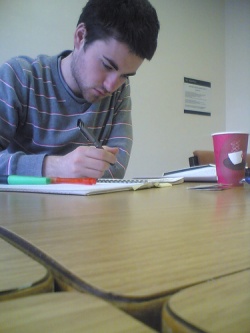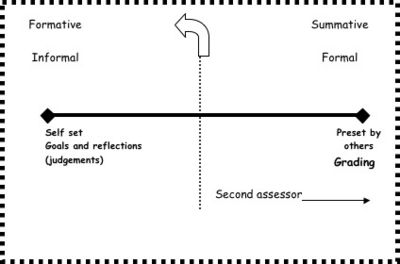Assessment methods and tools
| Foundation Skills | |
|---|---|
| Basics of assessment - principles and tools | |
| Assessing learning and providing meaningful feedback | Objectives | Assessment methods | Strategies for assessing learning and giving feedback | Summary |
Most commonly, assessment is considered to drive learning in higher education. However, Phil Race (2014) considers that there is much that needs to be changed in higher education so that assessments are designed to encourage learning, and not just surface or strategic learning, but deep learning.
Race argues in his book: Making learning happen (2014) that comprehensive formative feedback is essential for supporting students' learning, and some assessments such as exams are not suitable for providing this. In fact, Race suggests that although exams are good for some subjects and for the quantitative testing of facts (e.g., mathematics), they are not useful for measuring students' understanding in 'real world' situations. In Table 4.3 on page 106, you can view his comparison of the advantages and drawbacks of 11 forms of assessments, ranging from traditional exams, reports, portfolios etc. through to posters and artefacts.
- Defining Assessment Methods and Tools
- An assessment method is defined as the philosophical or pedagogical approach to assessing. For example, whether the assessment is written, practical, verbal, formative or summative.
- Assessment tools are more specific and used with different assessment methods. For example, posters, essays, or exams could come under 'written assessments', and interviews could be a tool used with verbal and practical assessment methods. In other words, assessment tools can be used across a number of assessment methods. Also, the tools used to mark assessments, for example, marking rubrics can be considered as assessment tools.
- Assessment methods
In this topic here, you are asked to think about how you currently assess, and also consider the attributes of some alternative assessment methods such as self and peer-assessment, practical assessments and Recognition of Prior Learning (RPL). How to choose assessments and assessment tools that will measure specific forms of learning, is discussed in the next topic: Strategies for assessing learning and giving feedback.
- How satisfied are you and your students with the assessments currently used in your courses?
- Perhaps record your thoughts so you can return to them later on.
- Self-assessment and peer assessment
For this topic, please refer to Dorothy Spiller's (2012) booklet: Assessment Matters: Self-assessment and Peer Assessment. Explanations about these types of assessment are outlined along with reasons for using them and some examples. A table of the features of good and poor practice in self-assessment is included. This resource is relevant for any context and Spiller uses research literature to support her claims.
Self-assessment is increasingly being used as an assessment tool in tertiary education. This type of assessment enables students to evaluate progress with their learning. If you are to use self-assessment, then it would probably work best if you give students clear objectives (or competencies), together with explicit criteria against which to judge their performance. You may even want to involve students in some of these areas (i.e., setting objectives, identifying competencies, developing criteria for judging performance).
Peer assessment involves students evaluating the work of their peers, for example, in a group work situation. As in self-assessment, clear objectives and explicit criteria should be agreed upon beforehand. Students individually assess each other's contribution using a rubrics list of criteria. This type of assessment works well in situations using co-operative learning (teacher-directed group tasks) and collaborative learning (student-driven project work).
In order to help students make judgements about their learning, you could use a rubric. A well-designed rubric makes self-assessment much simpler for the student. You can view an example of a rubric, used for self-assessment in a Design and Production programme in the Drama School at Carnegie Mellon University. Such a rubric can easily be modified for use in your own context.
- Can you identify advantages and disadvantages of self-assessment and peer-assessment?
- Assessing practical skills and knowledge
Learning in practical vocational settings can occur in a variety of environments, both on-campus and off-campus. For example: the workshop (engineering, trades), the gym (sports and exercise science), the art studio (painting, sculpture), the computer suite (information technology, graphic design), the kitchen and restaurant (cooking and hospitality), the salon (hairdressing), clinical labs (nursing and midwifery).
In most vocational programmes students are offered the opportunity to develop their practical skills and knowledge in real workplaces - building sites, offices, hospitals, community organisations. Different terminology is used, such as fieldwork, clinical placement, community placement, supervisor, preceptor etc. Generally, practical work is assessed in some way both formatively and summatively.
Observation is a good way to measure practical competence, and this may be accompanied by written activities such as worksheets or written reports or the creation of products. In the following activity, you will be asked to look at some different methods.
| Vocational assessments.
1. Consider some practical assessments.
2. View one or two of the following videos showing different approaches to practical assessment:
3. Please read this article by Pam Huddleston (2016) How should we assess vocational and practical learning?.
|
- Recognition of Prior Learning (RPL)
In situations where students have previous qualifications or experience, a Recognition of Prior Learning (RPL) process might be considered. available. Each organisation will have different policies and procedures in place, and these are worth checking. For example, in the health programmes at Otago Polytechnic students may get a cross credit or RPL for university or other relevant tertiary level courses they have successfully completed.
Assessment of Prior Learning (APL) is a specialised process and study pathway whereby a person with extensive work experience can enrol to prepare a portfolio of evidence, demonstrating how the Graduate Profile Outcomes (GPOs) for a specific programme are met. CapableNZ offers this service at Otago Polytechnic.
References
- Dunn , L. (2011). Selecting methods of assessment. Oxford, UK: Oxford Brookes University. Retrieved from http://www.brookes.ac.uk/services/ocsld/resources/methods.html
- Based on the work of Chris Morgan (1999) from Southern Cross University, New South Wales, and originates from the work of Nightingale et al. (1996).
- Race, P. (2014). Making learning happen. London: Sage Publications Ltd. (Available in the Robertson library and by searching Google Books.)

